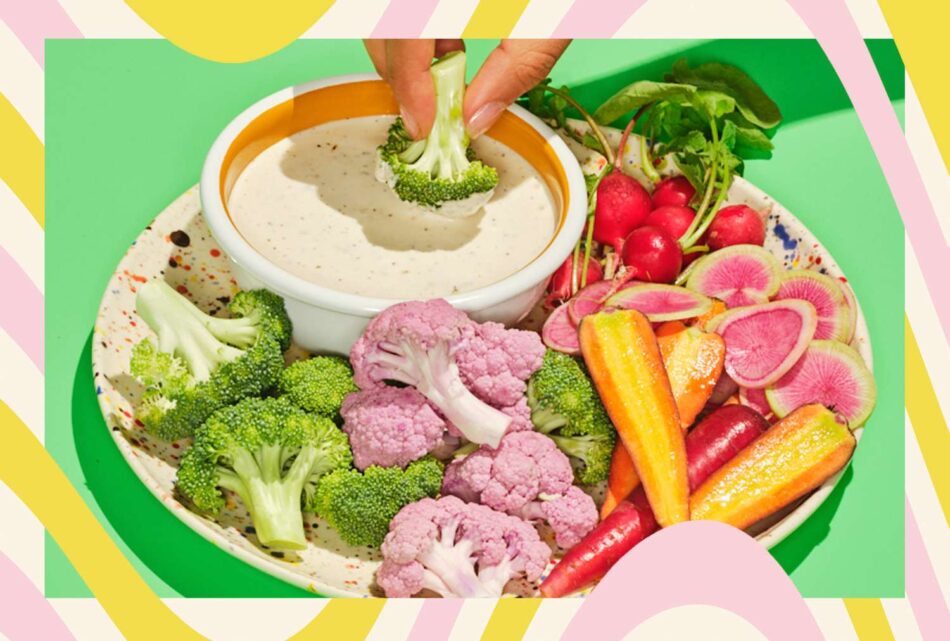- Dietitians believe that ranch dressing can increase your intake of vegetables.
- Look at the total calories, saturated fat, sodium and added sugars when choosing a salad dressing.
- You may find healthier ranch options in the refrigerated section of the grocery store, or you can mix it with Greek yogurt.
Like many foods, salad dressing has had its day playing the role of the villain. We’ve been told to only use a bit of olive oil and vinegar, to dip our fork tines in dressing rather than tossing it with greens or maybe even to just eat our salads plain.
But we know that salads don’t have to be sad—even when you’re watching your health or are aiming to lose weight. There’s far more to the salad dressing debate than just declaring one “good” and another “bad.” We’re here to assure you that if you’re a dressing fan, that is OK. In fact, nutrition experts actually encourage it, if it gets you to move the needle on eating more from the produce patch.
After all, just 1 in 10 American adults are eating the recommended 2 to 3 cups of vegetables every day. That means we have a lot of wiggle room to come up with more creative ways to get you to eat more vegetables. And that’s where this beloved dressing comes in.
The Salad Dressing You Should Consider Buying
It’s ranch! Classic to the American core, ranch dressing is by far the epitome of dressing stardom in the United States. But with that distinction comes the backlash from naysayers regarding its nutritional value—or lack thereof.
However, ranch can certainly get most people to enjoy more vegetables in their diet. “From a physical health perspective, part of what determines whether a food benefits an individual is the company it keeps!” explains Malina Malkani, M.S., RDN, owner of Malina Malkani Nutrition and author of Safe and Simple Food Allergy Prevention. “Ranch dressing may not be the most health-promoting food on its own, but it pairs well with vegetables, and when served drizzled over a salad, it increases the likelihood that people will eat more health-promoting produce.”
In my experience, a surefire way to get everyone to eat more sliced veggies is to have a bowl of ranch at the table. Not only would my 94-year-old grandpa dive into this bowl with his carrot in tow, but so would my 3-year-old daughter. It’s the timeless staple that just needs a good ol’ veggie to carry it home—and into your belly.
Malkani says that serving ranch, a dip that kids usually enjoy, is a great way to appease picky eaters. “I find that when parents serve veggies along with a dip that kids like (like ranch), picky eaters feel a greater sense of ownership and control over each bite of food and are far more likely to accept—or at least taste—vegetables that they otherwise would have refused,” she explains.
So, there you have it. Ranch, a salad staple for many, can be welcomed back into your kitchen —with the approval of dietitians!
What to Look For When Choosing a Salad Dressing
With so many salad dressings available, it helps to know a few things to look for at the store in order to choose one that’s good for you. Once you grab one that looks tasty, flip it over and check the nutrition facts for saturated fat, sodium and added sugars—the goal is to find one that’s lower in these three categories, says Malkani.
Consider your health. If there are nutrients your doctor has recommended limiting, such as sodium or saturated fat, you’ll want to take those into consideration when making your choice. Here’s a quick guide based on our nutrition standards at EatingWell, for a 2-tablespoon serving of dressing:
- Total Calories: Aim for less than 100 calories per serving.
- Saturated Fat: Aim for less than 2 grams per serving.
- Sodium: Aim for less than 140 milligrams per serving.
- Added Sugars: Aim for less than 3 grams per serving.
Now, take a deep breath if the bottle of dressing you’re holding right now is nearly double what we’ve suggested above. It doesn’t mean other dressings are off-limits. Rather, these are dressings you’d want to eat in moderation. “People often consider dressings as ‘bad’ foods because the nutritional value is low and they may just be seen as ‘added calories,'” says Sarah Schlichter, M.P.H., RDN, a family nutrition expert and owner of Bucket List Tummy. “However, they can provide a lot of flavor and enjoyment to foods, so I encourage people to choose them in moderation.”
Bringing the joy back to eating is an important factor in getting people to consume more of foods they may generally avoid—like veggies. Dressing can be a way to do it. It can be easy to go overboard on the serving size, but you want to be mindful of your pour, says Schlichter. If this seems challenging, consider pre-portioning your salad dressings in individual containers.
Tips to Increase the Nutrition of Ranch Dressing
While dietitians may give the green light on ranch dressing, we also want you to proceed with a few pointers in mind. With a few simple swaps, you can make ranch a good-for-you, nutrient-boasting food that will add some serious nutrition to your meal plan. Follow these tips from Malkani and Schlichter:
When Purchasing Pre-Made Ranch Dressing:
- Look for brands in the refrigerated aisle, as these are often prepared with less saturated fat and sodium. They often pack more protein, too, especially if you find one made with yogurt.
- Boost the protein content at home by combining ½ cup bottled ranch dressing with ⅓ to ½ cup nonfat plain strained (Greek-style) yogurt.
- Mix ranch dressing with salsa to enhance the flavor and texture—and add a nutrient boost from the tomatoes.
Photographer: Johnny Autry; Stylist: Charlotte Autry
When Making Your Own Ranch Dressing:
- Swap out the mayonnaise for strained (Greek-style) yogurt. Start with a 50-50 split and adjust the proportion of yogurt based on your taste preferences.
- Opt for reduced-fat sour cream and mayonnaise to lower the saturated fat content. Be mindful of the sodium and added sugars each brand provides.
- Lower the sodium by reducing the salt by half or a third of what the recipe calls for.
- Enhance the flavor with fresh herbs and spices.
- Consider a plant-based swap, like silken tofu, to boost the protein and offer vegan eaters a chance to dive into your dip.
Our Expert Take
Including dressings—like the classic ranch dressing—in a balanced diet can fit in a healthy meal plan, according to dietitians. Consider making your own using a higher-protein base, like strained (Greek-style) yogurt or cottage cheese, or purchase brands that align your personal health goals, such as those with less sodium and added sugar.









